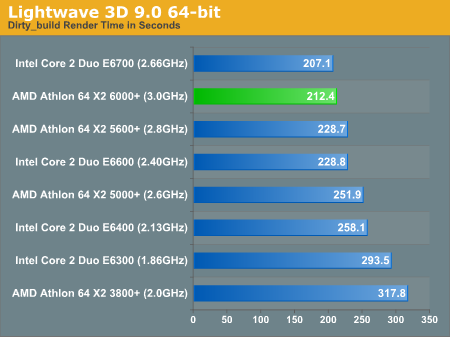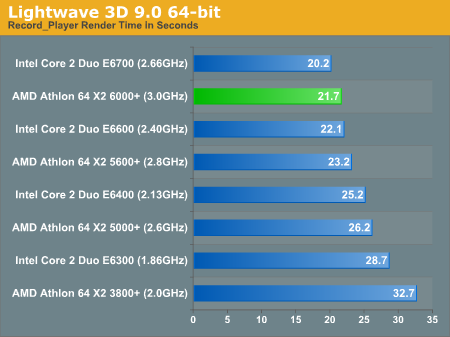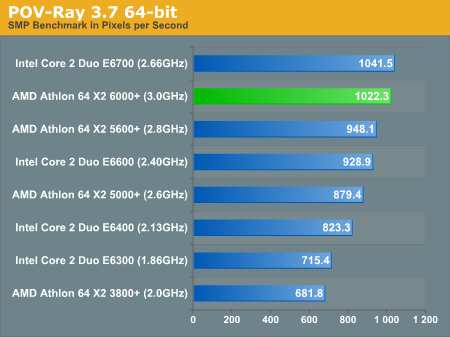AMD Athlon 64 X2 6000+: Competing with Aggressive Pricing
by Anand Lal Shimpi on February 20, 2007 3:37 PM EST- Posted in
- CPUs
3D Rendering Performance
We've moved on to using 3dsmax 9, which allows us to run a 64-bit version of the program for our tests. The test scenario is still made up of the CPU rendering tests of the SPECapc 3dsmax benchmark. We report the rendering composite, which is simply the geometric mean of render times across seven benchmarks normalized to a set of reference scores. We ran 3dsmax 9 using its Direct3D driver given the poor state of OpenGL performance under Windows Vista.

3D rendering performance under 3dsmax has proven to be one of many strong poitns of the Core 2 lineup, and the trend continues here under 64-bit Vista. The E6700 outperforms the newly released 6000+ by just over 15%, with the E6600 and E6400 following suit.
Lightwave 3D 9.0 is available with 64-bit support, giving us another 64-bit 3D rendering test. We looked at performance under two scenes that ship with the program: Dirty_Building and Record_Player. We measured the time it took to render the scene in seconds, lower numbers are obviously better.

Lightwave performance is far closer between the contenders, as the E6700 and 6000+ are basically tied in our first benchmark. The same is true for the E6600 and the 5600+, while the 5000+ is actually slightly faster than the E6400.

Intel gains a little more of an advantage in our next test scene, but the numbers continue to be quite close. If Lightwave is where you spend most of your time, AMD seems to be quite competitive with Intel here.
POV-Ray's ray tracing benchmark has been a popular CPU test for quite some time, and we turn to its 64-bit SMP beta to stress the CPUs here today:

Performance is extremely close between the Core 2 and Athlon 64 X2 families, there's no clear winner here although once you get down to the E6400 the X2 5000+ becomes a bit better of an option.
Our final 3D benchmark is the 64-bit version of Cinebench 9.5, a fairly popular 3D rendering benchmark due to its ease of use and quick runtimes. We ran the multi-threaded CPU rendering test and reported the final score in CBmarks. Higher numbers are better:

The Cinebench results are further cause for celebration for AMD, performance is higher on the green side of the fence at each price point we targeted for this review.










34 Comments
View All Comments
defter - Wednesday, February 21, 2007 - link
The maximum measured 8800GTX power consumption is about 150W. NVidia has mentioned that absolute maximum is 180W. However, since this is a CPU review, it's logical to assume that they stressed only the CPU in "full load" power consumption test.poohbear - Wednesday, February 21, 2007 - link
wow so 260w load plus 50w for a 8800gtx, thats only 310wts! kinda strange when companies are selling 1kilowatt psus.:/poohbear - Tuesday, February 20, 2007 - link
i was gonna ask the exact same question. I wish they'd clarify that in the articles when they talk about power consumption. Is that 263wts under load for the 5600+ JUST for the cpu or the whole system? thanks for any of the writers who can clarify this 100%.JarredWalton - Tuesday, February 20, 2007 - link
Power reports are always for the entire system. Obviously, lower end GPUs would reduce total power requirements quite a bit, but in maximum load testing the stress is only on the CPU and not the GPU. Thus, the ~50W power difference is going to remain whether you're running an 8800 GTX or an X1300 SE. The latter would simply use probably 40-50W less total power.bamacre - Tuesday, February 20, 2007 - link
Add in OC'ing and Intel, still, jumps further in the lead.BladeVenom - Tuesday, February 20, 2007 - link
But most people don't overclock.ViRGE - Tuesday, February 20, 2007 - link
Many of the readers of this site do though. The C2D is so mind numbingly easy to overclock, it's hard to not do it.Roy2001 - Tuesday, February 20, 2007 - link
I agree. I never OCed before. But with E6400 it is so easy. I just changed FSB from 266 to 350, I have a 2.8Ghz C2D. No voltage change, no cooling change. That's easy.mino - Tuesday, February 20, 2007 - link
Not to mention 800FSB E4300 parts.2.66/333FSB is pretty much a safe bet on most boards.
Even 2.13 for $150 is nice with board at STOCK FSB!.
Who needs E6400 then :) (for stock performance).
poohbear - Tuesday, February 20, 2007 - link
well if a 2.4ghz C2D can beat a AMD64 @ 3.0ghz, then calling a C2D @ 3.2ghz (the average overclock from what im reading) the "king" processor is a monumental understatement. It'd rape the 6000+.